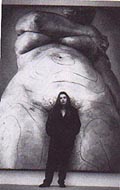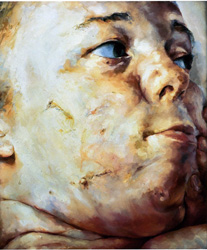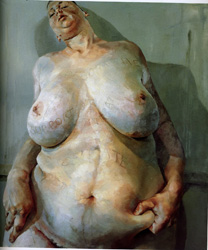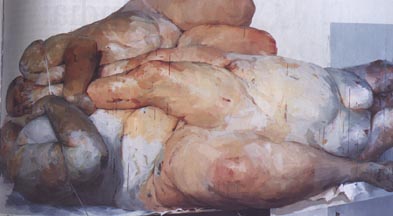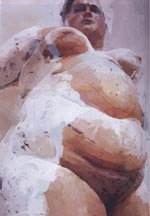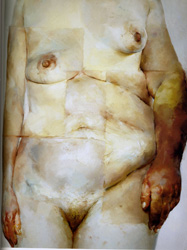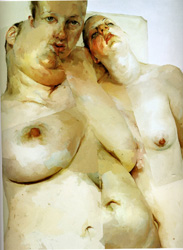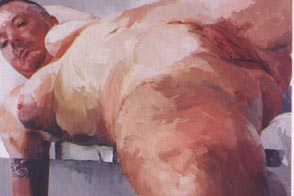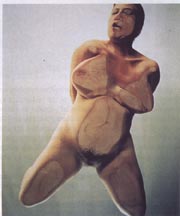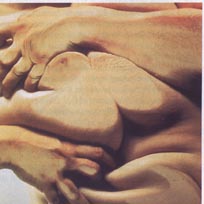Art Home | ARTH Courses | ARTH 200 Assignments | ARTH 220
Gallery of the Art of
Jenny Saville
In your journal I want you to compare Jenny Saville's Plan to Dürer's illustration of the Artist Drawing the Nude. Note the striking similarity between the point of view Saville represents and what we imagine the artist sees through the grid in the Dürer illustration. Also compare Plan to the Venus of Willendorf. Consider also Courbet's 1866 painting of a female nude he entitled The Origin of the World. As the text below indicates, the marks incised into the figure can be seen as connected to liposuction. What do you make of this? What do you make of her gesture? Compare it to the pudica gesture we have discussed.
Areas of Flesh
David Sylvester
Originally published in The Independent, January 20, 1994
When Jenny Saville, aged 22, finished her course at Glasgow School of Art in the summer of 1992, the British Art collector Charles Saatchi offered her an exhibition at his gallery in London. Some of her over-life-sized paintings went on show there last Friday [January 28, 1994]. She talked to David Sylvester about two of them: first "Plan", the nude, and "Interfacing."
The lines on her body are the marks they make before you have liposuction done to you. They draw these things that look like targets. I like this idea of mapping of the body, not necessarily areas to be cut away, but like geographical contours on a map. I didn't draw on to the body. I wanted the idea of cutting into the paint. Like you would cut into the body. It evokes the idea of surgery. It has lots of connotations.
I spent a long time on this one. I like the idea of concentration on the body. And there is obviously some sort of vulnerability here, because having liposuction in the first place-- you've got to have some sort of vulnerability to go and get it. But I like the idea that there's also power and strength in the body at the same time. So again you're not sure; it's ambiguous. Some people think it shows a loving caress of the body. I never really perceived it when I did it in that way. For me, it's much more to do with the fact that women who have got very large breasts pull them up to have a look at the rest of their body. You want to see the rest of your body but you can't without lifting up your breasts. So it's this idea of self-examination that I saw in it.
The head is mine. In fact, this painting is really based on me. I use me all the time because it's really reliable, you're there all the time. I like the idea of using yourself because it takes you into the work. I don't like the idea of just being the person looking. I want to be the person. Because women have been so involved in being the subject-object, it's quite important to take that on board and not be just the person looking and examining. You're the artist but you're also the model. I want it to be a consistent exchande all the time.
I use photographs a lot. I take lots of photographs of myself. There's a kind of snobbery against photographs when you do life painting. But I pillage information from anywhere. I really don't care where I get it from. I'll have photographs of my body, and sometimes I take photographs of bits of my friends' bodies, and I have lots of medical textbooks that I use as reference. For instance, if I want to paint stretch marks, then I'll look up in a medical textbook to find what causes them. Because if you can understand what makes them, you can understand how to paint them better. I don't take a photograph of a whole composition, just fragments of the body. Since I work on such a large scale, I don't paint while I'm looking at the figure. Usually I have a model for about six hours, and do about 10 rolls of real close-ups. But I don't use the model when she's in front of me. I just kind of try to take the knowledge with me. I don't want to get an illusion of a female body. I'm more interested in painting areas of flesh. It's as if the paint tends to become the body. It's like sculpture or something. When I put the paint on in layers, it's like adding layers of flesh. There are areas of thick flesh,where the paint becomes more dense.
Sometimes I paint really fast. You go "Arghhhh, look at that bit..." and that's when you get a real excitement about an area you've done. It's kind of aggressive. But when you get something right there is no better feeling. It's just a great feeling, that it's right.
I find working from life really intimidating. I couldn't draw or paint on a size like that [indicating a medium sized sketchbook]. I find it so hard to do --unless I do a detail of an enlargement or something. There is no point in me doing a study like that. It's just more natural for me to use larger areas of flesh. I don't like working in a life-class. There's no recognition from the model; he or she's sort of indifferent. I don't get anything from it.
I don't make preliminary sketches, either. I might break off and make a quick drawing on a piece of cardboard or some thing if I want to loosen an area up, but I'll do that in paint.
I work up scaffolding a lot, you see, because I can't reach the top of a painting. Going up and down ladders gets on your nerves after a while. You get up there and you think, I don't know where I was going to put that mark.
I use a huge amount of mirrors set up all the time because my studio doesn't go back very far, and when I work, I'll turn round all the time to the mirror. I use the mirror more than actually looking at the piece myself. I don't use the mirror to look at my own body, just to look at the painting. I have a mirror on an easel really high up, and then about seven mirrors all the way round. So if I paint a bit there, I will look round like this [turning round]- when I work I don't walk back all the time. Sometimes I've got clothes on, sometimes I haven't. Pubic hair is just a completely different sort of hair than on your head. Sometimes when it moves round, its density changes. Some people's go right up their stomach or right down their legs, and people never paint that because they think it's unsightly, you know, bikini line. Once pubic har gets further up, it combines with the flesh much more than on your head. It took me a long time to get the legs to work formally on this one, because the boundaries of the legs seem to go out so far. Women seem to think their legs extend forever. I've got a think in my studio that I found, it was about "how you can have great legs, too," or something. And it had the perfect leg and ankle measurement. Jerry Hall was fine, but Fiona, who used to do GMTV, her knees were far too big. It went through all these celebrities. "Lulu's Thigh Battle" and all this stuff you could do to make your legs better. You see, if the majority of women have legs in a certain way, then that's the way legs are. But this is like a minority of people telling the majority that they are wrong.
When I did the head [see "Interfacing"], I had a wart on my face too, like her. Everybody used to look at it. It became quite an obsession, so the whole painting grew out of this idea: that all everybody ever sees of you is this wart. So there's no background. The whole thing's flesh.
And you think that wart is bigger that it actually is. It's as if it spreads on to the cheek, like you've got this like huge growth taking over your head. I had it about a year. It sort of went away and came back; eventually I got it surgically removed.
It has the same sort of intensity you get when you look in the mirror. I think people pull their faces around more then. I mean people do things in front of the mirror that they'd never do in front of other people. They have this image of themselves in the mirror. I wanted that intensity, the way you look at yourself when there's something wrong. That's all you see. You don't see any background, the background's irrelevant, all you see is you.
There is a thing about Beauty. Beauty is always associated with the male fantasy of what the female body is. I don't think there is anything wrong with beauty. It's just what women think is beautiful can be different. And there can be a beauty in individualism. If there is a wart or a scar, this can be beautiful, in a sense, when you paint it. It's part of your identity, Individual things are seeping out, leaking out.
What comes out of these paintings is a fascination with the body. I think you have to sit back and think about the actual structure of the body underneath. Where the heat it. I mean, people who are seen as fat or overweight, who have like large bums, usually have circulation problems, so there's a coldness of lfesh next to the heat of a forearm. I think a lot of people don't think about how the body's made up. So it's that kind of thing I'm actually working on. I like thick paint. I think you've got the solidity of the body of the paint itself. But there are areas of flesh that aren't thick. So using thick paint's not appropriate. The feeling isn't big lumps and bumps. So sometimes I use thick paint, sometimes I use thinner paint. I don't have like a method, saying I'll build up slowly. I don't do any of that. I kind of draw it up sometimes, I have a basic outline of what I want, and start moving it about. But I'd never say that I started every painting in the same way at all. It's a sort of patience of trying things out and putting it in and taking it out. And just saying "give it a go." Because it's never the way you conceive it to be at all, and I don't think there's anything wrong in that, but lots of people get disappointed because they think: "I want it to be this." But I think if you keep going it becomes something. You grow every time you do a piece, anyway. You become the person in the painting or the painting changes you and your perception of things anyway.
So I don't think there's anything wrong in having a completely different image to the one you set out with in the beginning.
Excerpts from Alison Rowley, "On Viewing Three Paintings by Jenny Saville: Rethinking a Feminist Practice of Painting," in Griselda Pollock ed., Generations and Geographies in the Visual Arts: Feminist Readings
p. 93:
| Her canvases are very large, conventionally so, but that she should then impose upon them out-size image of the figure that are often too big for them, is rather less expected. That these images should then be positively outrageous --fat, bloated, distorted female nudes, scratched and scrawled with slogans and graffiti, gleefully flouting all canons of taste and decency --only compounds the visual shock. (William Packer, Financial Times, Friday 28 January 1994). |
There tends to be, in the rhetoric, itself overblown, surrounding Jenny Saville's work, a conflation of very large woman and very large canvas. In this respect also the Hunter Davies Interview photograph can be read as symptomatic. The 'small' figure of Jenny Saville posed in front of Plan does indeed produce the effect of the hugeness of the depicted woman. The canvas is obviously much larger than the figure of Saville herself, yet to reiterate her own words about Plan, 'The head is mine, in fact the painting is really based on me'. This might prompt us to ask the question: is this a huge woman, or is it a canvas a good deal larger than the size of the a human being, on which a composition is constructed so that the frame is nearly all filled with the head, torso and hips of a female figure? The canvas in fact measures 9' X 7'/ Why Saville might choose a canvas 9' X 7', how she manages to fill it with almost all body, and why she should want to do so must now be considered if we are to unravel wherein lies the hugeness of Plan.
The figure is, to begin with, hugely foreshortened. This allows Saville, first of all, to fill well over the bottom two-thirds of her canvas from edge to edge with painted flesh and hair: the thighs and pubis of her female figure. But is the figure lying down or standing up? The bottom edge of the canvas stops it at the thighs. The surface around where the torso begins, from the hips, to recede towards the head is painted a neutral grey, tonally modulated enough to allow it to read as space but with nothing to indicate whether it might be floor or wall. Does the depicted female figure look down at us to where we might imagine ourselves positioned in the space of the picture in relation to her at roughly knee height? Does she look along her own body at us from where she is lying to where we /p. 94: might imagine ourselves sitting or crouching somewhere by her knees? Are we really allowed a viewing position within the represented space of the picture at all? Can we imagine how we would place ourselves as the painter in the space of the studio in order to paint this view of the model? The picture is spatially ambiguous, the figure seems neither to stand nor to lie but to be tilted at a 45-degree angle between the two. The effect is as if the canvas is a large mirror which has been placed on the floor to catch the woman's reflection and then tilted upwards slightly from the back. The narrative of the depicted space is not one in which we can easily imagine ourselves as part of the story as a character (except perhaps, and perhaps revealingly, as a child hanging onto or sitting on her knees). Neither in the imagined narrative of painter and model in the studio, is it easy to determine what would be their spatial relationship. If the painter is indeed her own model, the narrative is one of self-examination to which we as viewers are witnesses.
 Griselda Pollock has argued that the fraught relationship between painting and feminism can be 'rhetorically tracked in the contradictory placements and significations of two bodies the "body of the painter" and the "feminine body".
Griselda Pollock has argued that the fraught relationship between painting and feminism can be 'rhetorically tracked in the contradictory placements and significations of two bodies the "body of the painter" and the "feminine body".  In Matisse's The Painter and His Model of 1917 Pollock identifies as represented "three orders of space which define modern western art-making":
In Matisse's The Painter and His Model of 1917 Pollock identifies as represented "three orders of space which define modern western art-making":
| It is a social space shaped in the concrete social and economic relations in one particular studio in Paris in 1917 in which a white bourgeois man paid a probably working-class woman to work for him. Then it is a representation of the symbolic space of art, the studio, and it makes a statement about the components of artmaking --the artist, the model, and the site of their one way transaction, the canvas. Finally it presents to us the space of representation, that canvas, upon which is painted a fictive body which has been invented by the painter's look and gesture. A social and sexual hierarchy are pictured: the artist is canonically male (signalling the fusion of Culture with masculinity); his material is female (the assimilation of nature, matter and femininity). By its formal disposition of man/artist, woman/model, the painting articulates the symbolic value and symbolic gender in western modernism's discourse of the "body of the painter". |
With Plan, Saville collapses all three of these spaces. Working mainly from her own middle-class white body she renegotiates the social and economic relation between painter and model. The studio the, is no longer the space of a one-way transaction; this is self-examination. From the third space, the space of representation, the painting Plan, we can consequently read a rearticulation of western modernism's discourse of the "body of the painter". The represented body is no longer "the supine female object body" but the active female creative body examined in the practice of the "woman's body."
/p. 95: But why, it might be asked, does Jenny Saville use a canvas as large as 9' X 7' for her image, why not paint life-size? To begin to answer this question I want to continue with the idea of self-examination and turn to Saville's own words. Talking to David Sylvester about the contour lines incised into the paint of the figure in Plan, Saville says: " The lines on her body are the marks they make before you have liposuction done to you." Speaking about the image of the marked-up woman in The Hunter Davies Interview she says:
| I'm not painting disgusting, big women. I'm painting women who've been made to think they're big and disgusting, who imagine their thighs go on forever....I haven't had liposuction myself but I did fall for that body wrap thing where they promise four inches off or your money back. |
Does Saville then, worry about her own size? In the company of thinner women, looking at photographs of the models in Cosmo's exercise regimes, does she feel that her body occupies a vast amount of space by comparison? Informed by the work of Freud and Foucault, it would be possible to read as signified by the size of the canvas for Plan Saville's figuration of the psychic dimensions of her own body, as it is constructed at the intersection of her physical body with all those discourses, of the fashion and cosmetics, the diet, health products and plastic surgery industry, that operate to produce the sign 'desirable feminine body' for this culture as something other than her size and shape. The composition of the figure within the frame strengthens this signification: not only does it need a canvas 9' X 7' to accomodate it but even then it's a squash to get it in. In her work work on Degas, Heather Dawkins has referred to the body as a 'memorable space'. On one level it is perhaps the memory of the mismatch, as it is lived from day to day, between a female body of a particular appearance and the culture's sign for the desirable, feminine body that is caught in the dimensions and represented space of Plan.
Branded, 1992, 7' X 6'
.
Fulcrum, 1999, oil on canvas, 8 1/2' X 16'.
Hem, 1999, oil on canvas, 10' X 7'.
Hybrid, 1997, 9' X7'
Ruben's Flap, 1998-99, 10' X 8'.
Matrix, 1999, oil on canvas. 7' X 10'.
#4, from the Closed Contact series, 1995-96, produced in collaboration with Glen Luchford, C-print and Plexiglas.
#12, from the Closed Contact series, 1995-96, produced in collaboration with Glen Luchford, C-print and Plexiglas.
See also the page dedicated to Jenny Saville at the Saatchi Gallery.
Consider Jenny Saville's work in relationship to the following excerpt:
Excerpts from Sandra Lee Bartky, "Foucault, Femininity, and the Modernization of Patriarchal Power,"in Feminism and Foucault, Irene Diamond & Lee Quinby eds., 61-86.
p. 64: We are born male or female, but not masculine or feminine. Femininity is an artifice, an achievement, 'a mode of enacting and reenacting received gender norms, which surface as so many styles of the flesh." In what follows, I shall examine those disciplinary practices that produce a body which in gesture and appearance is recognizably feminine. I consider three categories of such practice: those that aim to produce a body of certain size and general configuration; those that bring forth from this body a specific repertoire of gestures, postures, and movements; and those that are directed toward the display of this body as an ornamented surface. I shall examine the nature of these disciplines, how they are imposed and by whom. I shall probe the effects of the imposition of such discipline on female identity and subjectivity. In the final section I shall argue that these disciplinary practices must be understood in the light of the modernization of patriarchal domination, a modernization that unfolds historically....
Styles of the female figure vary over time and across cultures: they reflect cultural obsessions and preoccupations in ways that are still poorly understood. 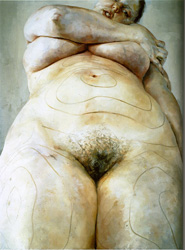 Today, massiveness, power, or abundance in a woman's body is met with distaste.
Today, massiveness, power, or abundance in a woman's body is met with distaste. 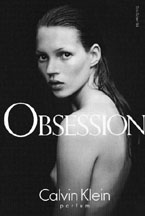 The current body of fashion is taut, small-breasted, narrow-hipped, and of a slimness bordering on emaciation; it is a silhouette that seems more appropriate to an adolescent boy or a newly pubescent girl than to an adult woman. Since ordinary women have normally quite different dimensions, they must of course diet.
The current body of fashion is taut, small-breasted, narrow-hipped, and of a slimness bordering on emaciation; it is a silhouette that seems more appropriate to an adolescent boy or a newly pubescent girl than to an adult woman. Since ordinary women have normally quite different dimensions, they must of course diet.
Mass-circulation women's magazines run articles on dieting in virtually every issue. The Ladies' Home Journal of February 1986 carries a "Fat Burning Exercise Guide," while Mademoiselle offers to "Help Stamp Out Cellulite" with "Six Sleek-Down Strategies." After the diet-busting Christmas holidays and, later, before summer bikini season, the titles of these features become shriller and more arresting. The reader is now addressed in the imperative mode: Jump into shape for summer! Shed ugly winter fat with the all-new Grapefruit Diet...!
Dieting disciplines the body's hungers: appetite must be monitored at all times and governed by iron will. Since the innocent need of the organism for food will not be denied, the body becomes one's enemy, an alien being bent on thwarting the disciplinary project....
p. 66: There are significant differences in gesture, posture, movement, and general bodily comportment: women are far more restricted than men in their manner of movement and in their spatiality. In her classic paper on the subject, Iris Young observes that a space seems to surround women in imagination that they are hesitant to move beyond: this manifests itself both in a reluctance to reach, stretch, and extend the body to meet resistances of matter in motion --as in sport or in the performance of physical tasks-- and in a typically constricted posture and general style of movement. Woman's space is not a field in which her bodily intentionality can be freely realized but an enclosure in which she feels herself positioned and by which she is confined. The "loose woman" violates these norms: her looseness is manifest not only in her morals, but in her manner of speech and quite literally in the free and easy way she moves.
In an extraodinary series of two thousand photographs, many (p. 67) candid shots taken in the street, the German photographer Marianne Wex has documented differences in typical masculine and feminine body posture. Women sit waiting for trains with arms close to the body, hands folded together in their laps, toes pointing straight ahead or turned inward, and legs pressed together. The women in these photographs make themselves small and narrow, harmless; they seem tense; they take up little space. Men, on the other hand, expand into the available space; they sit with legs far apart and arms flung out at some distance from the body....
But women's movement is subjected to a still finer discipline. Feminine faces, as well as bodies, are trained to the expression of deference. Under male scrutiny, women will avert their eyes or cast them downward; the female gaze is trained to abandon its claim to the sovereign status of seer. The 'nice' girl learns to avoid the bold unfettered staring of the 'loose' woman who looks at whatever and whomever she pleases. Women are trained to smile more than men, too....
Feminine movement, gesture, and posture must exhibit not only constriction, but grace and a certain eroticism restrained by modesty: all (p.68) three. Here is field for the operation for a whole new training: a woman must stand with stomach pulled in, shoulders thrown slightly back and chest out, this to display her bosom to maximum advantage. While she must walk in the confined fashion appropriate to women, her movements must, at the same time, be combined with a subtle but provocative hip-roll. But too much display is taboo....
[A] woman's body is an ornamented surface too, and there is much discipline involved in this production as well. Here, especially in the application of makeup and the selection of clothes, art and discipline converge....
A woman's skin must be soft, supple, hairless, and smooth; ideally, it should betray no sign of wear, experience, age, or deep thought. Hair must be removed not only from the face but from large surfaces of the body as well....
p. 71: Are we dealing in all this merely with sexual difference ? Scarcely. The disciplinary practices I have described are part of the process by which the ideal body of femininity --and hence the feminine body-subject-- is constructed; in doing this, they produce a 'practice and subjected; body, that is, a body on which an inferior status has been inscribed. A woman's face must be made-up, that is to say, made-over, and so must her body; she is ten pounds overweight; her lips must be made more kissable, her complexion dewier, her eyes more mysterious. The 'art' of makeup is the art of disguise, but this presupposes that a woman's face, unpainted, is defective.... The technologies of femininity are taken up and practices by women against the background of a pervasive sense of bodily deficiency: this accounts for what is often their compulsive or even ritualistic character....
p. 72: In the regime of institutionalized heterosexuality, woman must make herself "object and prey" for the man: it is for him that these eyes are limpid pools, this cheek baby-smooth. In contemporary patriarchal culture, a panoptical male connoisseur resides within the consciousness of most women: they stand perpetually before his gaze and under his judgement. Woman lives her body as seen by another, by an anonymous patriarchal Other.
